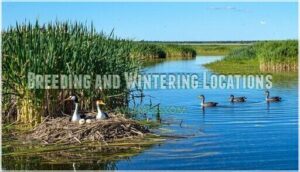This site is supported by our readers. We may earn a commission, at no cost to you, if you purchase through links.

This elegant waterbird measures 21-29 inches tall with piercing red eyes and pristine white facial feathers.
Clark’s grebe wasn’t even recognized as its own species until 1985, when scientists discovered it’s genetically distinct from the similar Western Grebe.
You can spot these diving specialists across western North America’s freshwater lakes during breeding season, where they perform synchronized courtship displays that’ll leave you mesmerized.
They’re underwater acrobats, plunging up to 20 feet to snag fish and aquatic insects with surgical precision.
The species faces growing challenges from habitat loss and climate change, making proper identification increasingly important for conservation efforts.
Table Of Contents
- Key Takeaways
- Taxonomy and Classification of Clark’s Grebe
- Physical Description and Identification
- Habitat and Geographic Range
- Behavior, Feeding, and Breeding
- Conservation Status and Protection
- Frequently Asked Questions (FAQs)
- Where do Clark’s grebes live?
- Who is Clark’s grebe named after?
- What is the difference between a Clark and a Western Grebe?
- Are grebes legal to shoot?
- Where do Clark’s Grebes live?
- What’s the difference between Western Grebe and Clark’s grebe?
- What do clarks Grebes eat?
- What is the incubation period of Clark’s grebe?
- Do Clarks Grebes ever nest alone?
- What are the best months for spotting Clarks Grebe?
- Conclusion
Key Takeaways
- You’ll easily recognize Clark’s grebe by its bright yellow-orange bill and white facial feathers that extend above the eye – this distinguishes it from the similar Western Grebe, which has darker facial markings below the eye.
- You’re witnessing remarkable underwater hunters that can dive up to 20 feet deep – they use surgical precision to spear fish, mollusks, and aquatic insects with their razor-sharp bills.
- You’ll be amazed by their synchronized courtship displays during breeding season – these elegant performances rival any ballet and help you spot them on western North America’s freshwater lakes from June through July.
- You can contribute to conservation efforts by reporting your sightings – Clark’s grebes face declining populations due to habitat loss and climate change, making citizen observations valuable for protecting these remarkable waterbirds.
Taxonomy and Classification of Clark’s Grebe
You’ll discover that Clark’s Grebe wasn’t always recognized as its own species—scientists originally lumped it together with the Western Grebe until 1985.
Genetic analysis and careful observation of mating patterns finally convinced researchers that these birds deserved separate species status, despite their striking similarities, which led to the recognition of Clark’s Grebe as a distinct species due to its unique characteristics.
DNA evidence and breeding behavior finally separated these look-alike birds into distinct species
Species Status and Genetic Evidence
Using DNA-DNA hybridization analysis, scientists confirmed Clark’s Grebe (Aechmophorus clarkii) as a distinct species in 1985.
Genetic distance studies revealed assortative mating patterns between Clark’s and Western Grebes, with interbreeding patterns showing rare hybridization despite broad sympatry.
This renewed specificity relies on bird genetics demonstrating reproductive isolation between subspecies populations.
However, studies suggest that interspecific brood parasitism may also play a role in the observed hybridization.
Historical Classification Changes
You’ll find that Clark’s Grebe wasn’t always recognized as its own species.
From 1886 to 1985, taxonomists lumped it together with Western Grebe as a single species, considering Clark’s merely a "white morph."
This Initial Confounding persisted until DNA-DNA hybridization studies revealed significant genetic differences.
The Taxonomic Revision in 1985 restored Clark’s Grebe (Aechmophorus clarkii) to Specific Status, supported by DNA Evidence and Assortative Mating patterns that demonstrated these weren’t just color variations but distinct species.
Recognized Subspecies and Their Range
Clark’s Grebe splits into two subspecies across distinct geographic regions.
You’ll find A. c. shift throughout western North America, from British Columbia to northern Mexico – this larger subspecies dominates most breeding range areas.
Meanwhile, A. c. clarkii inhabits Mexican highland lakes, particularly in Jalisco and Puebla.
These subspecies show minimal range overlap, with shift zones occurring only along Mexico’s northern border, creating clear habitat specificity patterns for subspecies identification.
Markedly, the species often hybridizes with the Western Grebe, which is a notable characteristic of the Clark’s Grebe, and this hybridization can lead to interesting interactions between the two species, resulting in a unique ecological dynamic.
Relationship With Western Grebe
You’ll discover that Western Grebe (Aechmophorus occidentalis) shares an intricate evolutionary story with Clark’s Grebe.
Scientists separated these species in 1985 after discovering assortative mating patterns and genetic differences. Despite broad sympatric distribution, hybridization frequency remains remarkably low, suggesting strong mate choice mechanisms prevent interspecies competition.
Key relationship insights:
- Plumage differences drive mate selection – Clark’s white facial markings extend above the eye
- Courtship display similarities make behavioral studies challenging for researchers
- Sympatric speciation occurred despite overlapping ranges across western North America
- DNA analysis revealed median sequence distances comparable to other Aechmophorus species
- Mixed pairings occur rarely, supporting adaptive mate choice theory
Physical Description and Identification
You’ll recognize Clark’s Grebe by its striking black-and-white plumage pattern and distinctive bright yellow-orange bill that sets it apart from other waterbirds.
This elegant grebe measures 21-29 inches in length with red eyes surrounded by white facial feathers that extend above the eye line.
Size, Color, and Wing Shape
You’ll spot this medium-sized waterbird stretching 22-29 inches with striking blackandwhite plumage patterns.
Clark’s grebe displays bold coloration patterns—dark blackish-brown back contrasting sharply with brilliant white underparts.
The wingspan reaches approximately 24 inches, while body mass ranges from 1.4-3.7 pounds.
Plumage variations remain minimal between sexes, though wing morphology shows subtle differences.
Bill length appears remarkably slender compared to similar species, complementing their elegant proportions perfectly.
Observing their beak shape helps in species differentiation for accurate identification.
Bill Color and Eye Features
Beneath the sleek black cap, Clark’s grebe displays striking bill coloration that sets it apart from other waterbirds.
You’ll notice the bright yellow bill with its distinctive upward curve, creating an elegant spear-like profile.
The red eyes surrounded by white facial markings create a bold contrast against the dark cap, and this greenish-yellow bill paired with crimson eye coloration makes identification straightforward for birders seeking these identifying features.
Distinguishing Features From Western Grebe
Looking beyond bill coloration reveals key facial markings that separate these species.
You’ll notice Clark’s grebe displays white feathers surrounding the eye, while western grebe shows black extending around the eye area.
Neck differences include Clark’s slightly longer, more slender profile, and plumage patterns and facial patterns remain consistent identifiers.
Hybridization rates stay remarkably low despite overlapping ranges, confirming distinct species status through behavioral and genetic isolation.
Habitat and Geographic Range
You’ll find Clark’s Grebes across western North America, from British Columbia down to central Mexico, with breeding populations favoring large freshwater lakes surrounded by emergent vegetation.
During winter months, these elegant waterbirds migrate to coastal areas along the Pacific, where they inhabit estuaries, bays, and river mouths from Alaska to Mexico, favoring areas that provide them with the necessary resources for survival, and they are known for their elegant appearance.
Breeding and Wintering Locations
You’ll find Clark’s grebes breeding across western North America’s interior wetlands, from southern Canada through the United States into Mexico.
These lake birds concentrate in California’s Central Valley, with major colonies at Clear Lake and Eagle Lake.
During winter, grebe migration takes them to coastal areas and southern reservoirs like the Salton Sea, maintaining habitat connectivity between breeding and wintering grounds.
More information about grebe nesting products can be found online, which helps understand breeding locations.
Summer and Winter Habitats
You’ll discover clarks grebe habitat preferences shift dramatically between seasons.
During summer breeding, they favor large inland lakes with emergent vegetation like reeds and rushes.
Winter brings migration patterns toward coastal habitats including estuaries, river mouths, and Pacific bays, avoiding Atlantic waters entirely.
Grebes require specific resources for successful nesting platforms.
- Breeding Season: Freshwater lakes and marshes with dense aquatic vegetation for nesting platforms
- Winter Quarters: Pacific coastal waters, estuaries, and brackish bays from Alaska to Mexico
- Habitat Threats: Water level fluctuations, pollution, and development around key lake birds breeding areas
- Preferred Features: Clear, shallow waters with abundant fish populations and minimal human disturbance
Shared Habitat With Western Grebes
Clark’s grebe (Aechmophorus clarkii) and western grebe share remarkable sympatry challenges across their breeding ranges.
You’ll find these similar species coexisting on identical lakes, yet hybridization rates remain surprisingly low.
Mate selection proves highly species-specific, with each grebe bird demonstrating adaptive preferences.
Resource partitioning strategies help reduce competition, though both species exploit similar fish populations and nesting sites throughout their overlapping territories.
Their geographic range products are widely available, which can be used to understand their geographic range.
Key Features and Locations
Where can you reliably spot Clarks Grebe (Aechmophorus clarkii) across the United States?
Key Geographic Hotspots include California’s Great Salt Lake, Colorado’s mountain lakes, and Nevada’s alkaline waters.
Their distribution spans shallow freshwater habitats with emergent vegetation during breeding season.
Seasonal Movements shift these birds to Pacific coastal bays for winter.
Regional Differences show larger subspecies in western North America, while distinctive plumage and Identifying Features remain consistent across Habitat Types.
Behavior, Feeding, and Breeding
You’ll discover Clark’s Grebes are among nature’s most elaborate performers, executing synchronized courtship displays that rival any ballet.
These skilled underwater hunters dive up to 20 feet to catch fish, while their parental dedication includes carrying chicks on their backs for protection and warmth.
Courtship and Nesting Habits
You’ll witness some of nature’s most spectacular courtship displays when observing Clark’s Grebes during breeding season.
These elegant waterbirds perform synchronized swimming rituals and elaborate head-bobbing ceremonies that captivate birdwatchers.
Their nest construction involves building floating platforms of vegetation anchored in shallow waters among emergent reeds.
Both parents share egg incubation duties for their bluish-white eggs over twenty-three days, demonstrating remarkable partnership in chick rearing responsibilities.
Nest building often relies on plant-based nesting materials for structural support, which is a key aspect of their nesting behavior and utilizes emergent reeds for stability.
Foraging Methods and Diet
When hunting underwater, you’ll watch Clark’s Grebes dive 10-20 feet using powerful thrust motions to spear fish with razor-sharp bills.
Their diet consists of 80% fish plus mollusks, crabs, salamanders, and insects.
Diving depths vary seasonally—deeper offshore waters during breeding, shallower coastal areas in winter.
Prey selection reflects local abundance through cooperative foraging strategies and opportunistic diet variation.
Parental Care and Chick Development
After eggs hatch, you’ll observe remarkable parental dedication in Clark’s Grebes.
Clark’s Grebe parents demonstrate unmatched devotion, sharing every aspect of raising their remarkable chicks
Both parents share brooding duties while their precocial chicks develop rapidly.
Here’s what makes their parental care extraordinary:
- Chick Precocity – Hatchlings swim within hours, covered in fluffy white down
- Back Riding – Young fledge safely by riding on parents’ backs during early weeks
- Cooperative Brooding – Both adults alternate feeding and protection responsibilities
- Parental Roles – Parents dive for fish while chicks wait on the surface
- Fledgling Period – Complete independence occurs after 63-77 days of intensive care
Conservation Status and Protection
You’ll discover that Clark’s Grebe faces mounting conservation challenges despite not being federally listed as endangered.
These elegant waterbirds encounter threats from habitat loss, water diversions, and climate-related changes to their preferred breeding and wintering areas.
Population Trends and Threats
Clark’s Grebes face significant population declines, dropping 8% between 1970-2017.
You’ll find their conservation status listed as "Least Concern" but they appear on Yellow Watch Lists due to habitat degradation and climate impacts.
Water pollution, invasive species, and human disturbance threaten breeding colonies.
Conservation strategies focus on protecting nesting sites and monitoring population trends across their range.
Habitat Loss and Water Quality
How do human activities threaten Clark’s Grebe populations? You’ll find these ecosystems under siege from multiple pressures:
- Water Diversion – irrigation projects drain essential breeding lakes
- Agricultural Runoff – pesticides contaminate aquatic ecosystems where grebes forage
- Wetland Degradation – urban development fragments critical nesting habitats.
Pollution impacts directly affect their fish prey, while habitat loss forces birds into suboptimal areas.
Wetland restoration efforts can’t keep pace with ongoing destruction.
Climate Change Impacts
Rising temperatures and altered precipitation patterns create cascading effects for waterbird species like Clark’s Grebe.
Habitat shifts occur as western lakes dry up, forcing birds into managed reservoirs. Breeding disruptions follow when water levels fluctuate unpredictably during nesting season.
Food scarcity develops as prey fish populations crash in warming waters. Migration changes reflect these pressures—aquatic birds now winter 895 kilometers farther south than decades ago.
Extreme weather events amplify these stressors, threatening bird populations and overall bird conservation status across North America. These changes highlight the impact on migration patterns, which is a critical aspect of bird conservation.
Conservation Efforts and Public Awareness
You can join efforts protecting Clark’s Grebes through multiple conservation pathways. State agencies have organized extensive Grebe Conservation programs reaching thousands, while Habitat Preservation projects restored over 2,000 acres since 2018.
Public Education initiatives and wetland protection advocacy create lasting impact for these remarkable waterbirds.
- Volunteer at wetland restoration sites where conservationists plant native vegetation
- Participate in Citizen Science nest monitoring programs collecting essential breeding data
- Support Policy Advocacy through wildlife organizations promoting bird conservation efforts
- Attend Public Awareness events showcasing habitat loss challenges and protection solutions
Frequently Asked Questions (FAQs)
Where do Clark’s grebes live?
Like Victorian-era naturalists with their field glasses, you’ll find these elegant waterbirds inhabiting western North America’s freshwater lakes and marshes.
They breed from British Columbia to Minnesota, then winter along Pacific coasts from California to Mexico, favoring shallow waters with abundant vegetation.
Who is Clark’s grebe named after?
The ornithologist William Clark of Lewis and Clark expedition fame?
Unfortunately, there’s no definitive record of who Clark’s grebe was named after.
You’ll find that many bird species carry surnames without clear attribution to their namesakes, and this is a complete example of how names can be used without clear attribution.
What is the difference between a Clark and a Western Grebe?
Scientists discovered these species were genetically distinct in 1985, ending 99 years of confusion.
You’ll spot Clark’s Grebe by its bright yellow bill and white facial markings extending above the eye, while Western Grebes have darker bills.
Are grebes legal to shoot?
No, you can’t legally shoot grebes.
They’re protected under the Migratory Bird Act, making hunting them illegal.
Mistaking these diving waterbirds for legal game during duck season can result in hefty federal fines and penalties, especially for violating the Migratory Bird Act.
Where do Clark’s Grebes live?
You’ll find Clark’s Grebes throughout western North America, from British Columbia down to central Mexico.
They breed on freshwater lakes with vegetation, then winter along the Pacific Coast in bays and estuaries.
What’s the difference between Western Grebe and Clark’s grebe?
You’ll spot key differences in their facial markings and bill color.
Clark’s Grebe has white feathers extending above the eye and a bright yellow-orange bill, while Western Grebe shows a darker face with white below the eye and a greenish-yellow bill.
What do clarks Grebes eat?
Clark’s Grebes can dive up to 20 feet deep, making them impressive underwater hunters.
You’ll find they primarily eat fish like carp and herring, but they also consume mollusks, crabs, salamanders, and insects.
What is the incubation period of Clark’s grebe?
You’ll find that both parents share incubation duties for about 23 days. During this period, they’ll take turns warming their bluish-white eggs on floating vegetation platforms until hatching occurs.
Do Clarks Grebes ever nest alone?
While breeding colonies sometimes form large gatherings, you’ll find many Clark’s Grebe pairs choosing to nest as solitary couples.
Particularly in Montana where most colonies contain fewer than ten breeding pairs.
What are the best months for spotting Clarks Grebe?
Like a seasonal calendar opening its pages, timing matters when you’re searching for these elegant waterbirds.
June and July offer your best chances during peak breeding season when Clark’s Grebes concentrate on large freshwater lakes for nesting activities and courtship displays.
Conclusion
While many waterbirds blend into their surroundings, Clark’s grebe stands out like a formal dancer on nature’s stage.
You’ve now learned to identify this remarkable species by its distinctive yellow-orange bill and elegant black-and-white plumage.
Understanding Clark’s grebe behavior patterns, from synchronized courtship displays to precise underwater hunting techniques, helps you appreciate their ecological importance.
As habitat pressures mount, your ability to recognize and report Clark’s grebe sightings contributes valuable data for conservation efforts across western North America’s freshwater ecosystems.












